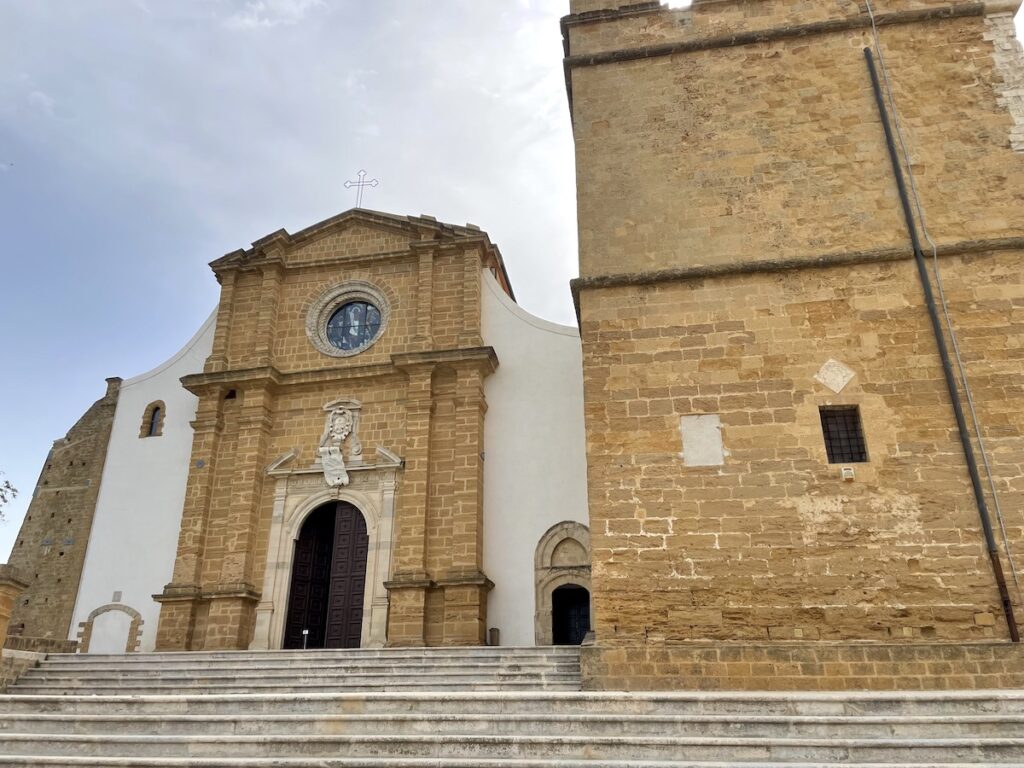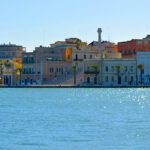At first glance, Agrigento (59.000 inhabitants) in southern Sicily does not look very attractive. A landslide in 1966 caused part of the old center to collapse, resulting in ugly high-rise buildings. Yet the old center with its small streets, beautiful facades and the shopping street Via Atenea is really worth a visit.

The Via Atenea runs from the 19th-century Porta Atenea – once a medieval city gate stood here – to Piazza Pirandello.


In 580 BC. Agrigento was founded by the Greeks who named the city Akragas after the river of the same name. After a war with the Carthaginians (480 BC), the city flourished and the building of the temples started.
In 406 BC. the Carthaginians retaliated and the city's prosperity was lost.
Later, in 210 BC. the city was conquered by the Romans who called the city Agrigentum, this caused the city to flourish. After the collapse of the Roman Empire came the Byzantines who neglected the city.

Table of contents
1. Cattedrale San Gerlando

De Cathedral San Gerlando, which is on the highest point of Agrigento, was built on a pre-existing temple at the end of the 11th century. In the following centuries, the cathedral was expanded, reduced, changed and yet brought back as much as possible in the medieval style.

The mishmash of styles gives something special to the church. Make sure to walk upstairs where you can admire the wooden ceiling up close. Next to the cathedral is a bell tower that you cannot visit.

Down an alley you come to the S. Maria dei Greci, a very small church built in the Middle Ages on the remains of a pre-existing Greek temple in Doric style.
Tip: in the cathedral you buy 1 ticket for € 6 with which you can view the museum of the cathedral, the cathedral itself and the S. Maria dei Greci.
2.Luigi Pirandello

Walk down from the cathedral and at Via Atenea turn right, you will come to a square with a statue of the writer and Nobel laureate Luigi Pirandello (1867-1936). He wrote many novels and plays.

Opposite this is a monastery, which also houses the town hall. Do walk in here to take a look at the Teatro Pirandello† This theater opened in 1870 and still has the curtained boxes, red plush seats and beautiful ceiling paintings. There is room for 700 people.

The Birthplace of Pirandello (casa natale di Luigi Pirandello) can be found in Contrada Caos-Villaseta, about 4 km southwest of Agrigento. Here you can see letters, photos, first editions of his books and beautiful handwritten pages.
The urn with the urn containing the ashes of the writer is buried under a boulder near a large pine tree. Pirandello had stipulated this in his will. However, it took 25 years before this wish of the writer was fulfilled, the urn was first buried in Rome, then went to the Museo Civico in Agrigento and was not buried under the pine tree until 1956. More information can also be found in the app 'casa museo Luigi Pirandello' (also in English).
3.Andrea Camilleri
On the Via Atenea towards the Porta Atenea you will come across the statue of the writer who died in 2019 Andrea Camilleri. Camilleri is best known for the books about it Montalbano, which have also been made into a film and have been on for a while Netflix stand.

Camilleri, who came from Porto Empedocle, went to secondary school in Agrigento until the school closed due to the Allied invasion in 1943. Rumors have it that the statue must be removed, as there is a rule that no statues of persons who not been dead for 10 years….
4. Festa di San Calogero (first to second Sunday in July)
According to tradition, the monk came Calogero to Sicily to spread the Christian faith and asked for bread for the poor during the plague. The inhabitants of Agrigento feared that Calogero would infect them, so they threw the bread in his cart so they wouldn't have to open the door for him. The residents still throw bread in the cart during the procession to commemorate this monk. In addition to the procession, there are concerts, exhibitions and the festivities are concluded with a large fireworks display.
5. Valley of the Templi

A bit outside Agrigento is the Valley of the Temples, the Valley of the Temples. The name is incorrect because the temples are not located in a valley, but on a hill, but they are lower than Agrigento. It has been on the UNESCO World Heritage List since 1997 and is one of the largest archaeological sites in Italy with thirteen hundred hectares.
Besides a number of temples, there are cemeteries, a number of city gates and the old gymnasium (ekklesiasteron) where the Greeks gathered to discuss problems. The Greek poet Pindar called it 'The most beautiful city of mortals'.
You can also visit the Giardino della Kolymbetra (near the Tempio dei Dioscuri), a beautiful garden with picnic areas and lemon and olive trees.
Tempio di Giunone (also called the Temple of Juno or Hera)

This temple is located on the highest rock on the east side of the valley. As with most of Agrigento's temples, it is not known for sure which god the temple is dedicated to.
Pliny the Elder referred in one of his books to the temple of Juno, but meant the temple at Crotone and not Agrigento, yet the temple has kept its name despite the erroneous reference.
The temple is 38 meters long, 17 meters wide and 25 columns are still standing. The temple was probably badly damaged by a fire during the conquest of the city by the Carthaginians, traces of the fire can still be seen on a wall in an interior space.
Temple of Concord
This is one of the 3 best preserved Greek temples in the world. The temple dates from the second half of the 5e century BC.

According to tradition, the temple was built in the 6e century into a Christian church, dedicated to the apostles Peter and Paul. Perhaps that is why it is so well preserved. The temple is over 39 meters long, almost 17 meters wide and has 6 pillars on the short side and 13 pillars on the long side.
Giardini dei Giusti del Mondo


If you go down the hill from the Tempio di Giunone towards the Tempio della Concordia you will pass the Giardini dei Giusti del Mondo, 'the garden of the righteous'.
Here you see a number of burial columns for people who fought for a better world and were therefore murdered. You can see a monument to Sophie and Hans Scholl, two members of the Weiße Rose who revolted against Nazism.
There are also columns for Giovanni Falcone, the judge who fought against organized crime, and who was blown up along with his bodyguards and wife. There is also a column for Paolo Borsellino who worked with Falcone and was killed by a car bomb in front of his mother's house 2 months after Falcone.
Tempio di Ercole (temple of Heracles)

This is the oldest temple in this area and dates back to 510 BC. The temple would have been as big as the Parthenon on the Acropolis in Athens and was 74 meters long and 28 meters wide. 9 columns can still be seen, originally there were 38 columns.
Tempio di Giove (temple of Zeus)
The temple was built after the victory over the Carthaginians in 480 BC. The columns were over 30 feet (113 m) high, and the temple was 56 feet (XNUMX m) long and XNUMX feet (XNUMX m) wide. Unfortunately, the temple was destroyed by earthquakes and now only a heap of stones can be seen. By the way, many stones were used for the construction of the harbor in Porto Empedocle, which is nearby.
Tempio dei Dioscuri (also called the Temple of Castor and Pollux)

Of this temple there are still 4 columns that support part of the architrave, these were partly restored in the 19e century and is a photogenic place.
The experts are less enthusiastic because the renovation in the 19e century it is not possible to determine the origin of the individual parts.
Archaeological museum
In the valley is also the Archaeological Museum, this museum is dedicated to Pietro Griffo, archaeologist and Superintendent of Agrigento from 1941 to 1968. It is located on San Nicola Hill, once the center of the old town. The collection consists of no less than 5688 objects.
In the museum you will learn everything about the ancient city of Akragas and the history of the Valle dei Templi, also temporary exhibitions and concerts are given here.
Practical information Valle dei Templi
There are 3 parking spaces, at the Tempio di Giunone, Porta V and Teatro Ellenistico. You can also buy an entrance ticket (also for the Archaeological Museum) at the parking lots. In various places there are restaurants / bars where you can eat and drink.
There is not much shade, so in hot weather it is wise to go early in the morning or late afternoon. The park is open every day from 8.30:20.00 AM to XNUMX:XNUMX PM, and often even longer in the summer months.
Scala dei Turchi
About 15 km west of Agrigento are the Scala dei Turchi, literally translated as 'The stairs of the Turks'.

These white rocks, shaped by wind and water into a kind of staircase, owe their name to the Saracen pirates (often mistakenly called Turks), who lived here in the 16th century.e century went ashore to plunder the coastal villages.
The rocks are from marl, a kind of white limestone and when the sun shines on it they are beautiful white and contrast nicely with the turquoise blue sea. Unfortunately, with less sun they are also immediately a lot less white.




The white rocks are a popular backdrop for various films. Here's a scene from the movie Malena by Giuseppe Tornatore (2000) and a scene in the series by The young Montalbano.
The rocks can be found in the village of Realmonte. There are several parking spaces where you can park all day for €5. From the road at Lido Scala dei Turchi a staircase with more than 120 steps descends.
Essential Information
How do you get to Agrigento?
If you are going to fly you can fly to Palermo as well as Catania and Trapani. flights, there are almost daily flights from Schiphol or Rotterdam to these cities. With your rental car it is still a minimum of 2 hours drive to Agrigento in the south of the island.
An alternative to a rental car is the bus. These generally run more often than the trains, see the website For more information. Of course you can also travel with your own car. For example, take the boat from Genoa to Palermo. The crossing takes approximately 20 hours.
Tip: include Agrigento in your tour of the island. This way you get the most out of your trip to Sicily.
Hotels
A must is B&B Terrazze di Montelusa† This B&B right in the center offers spacious rooms, is tastefully decorated and serves breakfast on a terrace with a beautiful view. The owner Francesco is friendly and helpful and sometimes plays the piano for his guests.


Restaurants
If you want to eat with a sea view, go to L'Operà in Via Atenea. In addition to pizzas, you can also eat delicious pasta here and they often serve a limoncello on the house. Other nice restaurants are Boccondivino or Dacànto where you eat on a staircase.

Would you like to discover the most beautiful places in Agrigento and the surrounding area for yourself?
You see it. Agrigento has a lot to offer. Are you in Sicily and do you want to immerse yourself in special culture, history and gastronomy? Then book one or more nights in Agrigento.
There is a lot of beautiful accommodations in Agrigento and also very affordable. Take a look through the wide range of hotels and holiday homes in the city.
Tip: this penthouse at number 2 Via Atenea, for rent via Airbnb.
Here you will find the best accommodations in Agrigento.










Comments